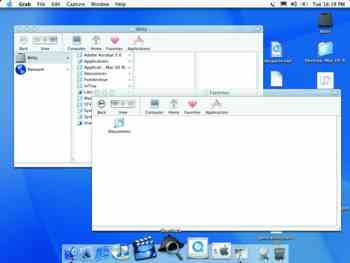Hello Computer
Graphical User Interfaces are still the dominant means by which we address our computers. Jason Walsh argues it’s time for an overhaul
 >> Apple's OSX [http://www.apple.com]
>> Apple's OSX [http://www.apple.com]
Apple released Mac OS X last year. Having used computers for almost twenty years, I can say that this new operating system is undoubtedly the best ever. Yet, there is an undercurrent of disappointment. There is something wrong with this OS. It’s not the MACH microkernel, the UNIX core or the fluid motions of the new GUI. Well, actually it is the GUI. It’s not a bad interface, it’s probably the best yet, but isn’t it about time we stopped pointing and clicking?
The Graphical User Interface emanates, famously, from the Xerox Parc, and was copied by Apple, then by Microsoft, then by Digital Research, then by... etc. It’s now 2002 and the GUI has yet to show many changes. It’s had facelifts and the odd major improvement, such as on-the-fly previewing and drag-and-drop, but the fact remains that an Apple Lisa user from 1983 could understand OS X as part of a continuum.
GUIs allowed new sets of uses for computers, notably desktop publishing, not just because they facilitated better display technology, but because they allowed people who weren’t educated in computer science to use computers. Command lines lend themselves only to those with an understanding of software architecture. Few users today realise that by clicking on Macintosh HD they are programming the computer. Linux users may be slightly more aware, but this is emblematic of the failure of the Linux GUIs to hide the underlying complexity.
There have been various attempts at modelling three-dimensional GUIs, notably under Linux and by Sun Microsystems, but there is an innate problem in displaying 3D on a 2D screen. No matter how well rendered, it’s an optical illusion. Furthermore, 3D will entrench the problems of the desktop. I have difficulty locating files in the mess that is my computer, making me look underneath a virtual-sofa isn’t going to help.
The paradigm is flawed – it was fine in 1984, but the processing power of the average el-cheapo generic Windows box, or iMac would be better deployed replacing the anti-intuitive desktop metaphor, than rendering old mistakes with special effects. When the iMac débuted, commentators noted that the round mouse was clumsy. Well spotted. Sadly, none of these people went on to note that mice are generally ill-conceived devices.
Futurologists have foretold the prospect of voice recognition, so where is it? Clumsy attempts by IBM and Apple amount to little more than automating desktop events. What is needed is software that knows when we’re present, when we’re addressing it, and has some basic conception of its purpose. This doesn’t require consciousness, or so-called artificial intelligence. There is a game for SGI workstations which uses webcam motion tracking to control the character. It’s a fairly small step to include face recognition and give the computer an idea as to when we’re addressing it. What is required is an acknowledgement that the entire desktop metaphor is holding us back from making computers that are more than glorified typesetting machines.
Jason Walsh <jmwalsh@rocketmail.com> is a practicing visual artist, currently researching for a PhD in New Media interface design
Mute Books Orders
For Mute Books distribution contact Anagram Books
contact@anagrambooks.com
For online purchases visit anagrambooks.com






